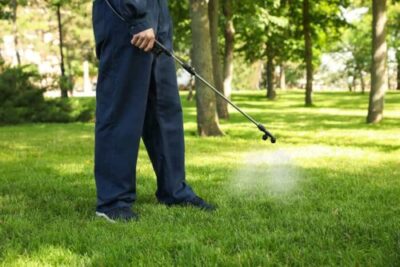When it comes to maintaining a lush and green lawn, there is a lot of hard work that needs to be done to keep your yard in top shape.
But, how long after lawn treatment is it safe for pets to go back out on the yard?
Disclosure: This article may contain affiliate links – that means we may receive a commission if you make a purchase after clicking on these links. This is at no extra cost to you.
From regular mowing and watering to fertilization and weed control treatments – your lawn has to go through a lot to stay fresh and attractive.
And although lawn treatments are necessary to keep your lawn healthy and protected from parasites and weeds – it can come with some negative results. The major downside of lawn treatment is how it can harm our pets and other wildlife.
How can we protect our pets from harmful chemicals? And how long after lawn treatment is it safe for our pets to play on the grass?
Why Should Pets Be Kept Away From Treated Lawns?
This answer to this particular question is a simple one – treated lawns are dangerous to pets because of the various pesticides and herbicides that are used to rid the grass of parasitic insects and weeds.
Research has shown that the chemicals inside insecticides and herbicides are highly toxic to dogs and other animals – and that exposure to these chemicals could make your pet seriously ill.
Scientific studies from 1991 and 2012 have shown that dogs from households that used chemical pesticides on their lawns were more likely to contract cancer – with 70 percent of these dogs not surviving the disease.
A study that was first published in 2013, discovered that traces of chemical herbicides can be found in a dog’s urine, which means that the animal is not only capable of being exposed to the chemicals, but that the chemicals can also stay inside your pet for years.
The study also allowed scientists to understand how the chemicals can enter the dog’s body and why chemical pesticides are so closely associated with bladder cancer in canine animals.
If you own a pet, such as a dog or a cat, you should not allow them to play on a lawn that has been recently treated with chemical pesticides. Or you could risk exposing your animal to chemicals that are detrimental to their health.
How Long After Lawn Treatment Is It Safe For Pets?
If you have recently had your lawn treated with fertilizer, insecticides and herbicides, then you should always keep your pets away from the yard. You must refrain from allowing your pets out and onto the lawn for around 24-72 hours, as this will give the chemicals sufficient time to be absorbed by the grass.
Because pets such as cats and dogs are small animals, they are closer to the ground and this means they are more likely to inhale or digest the harmful chemicals used to treat your lawn.
Dogs and cats are also highly territorial animals and they enjoy rolling around in their surroundings to spread their scent.
If a cat or dog were to roll in a recently treated lawn, they would be fully exposing themselves to the various chemicals that have been used to coat it – and this, in turn, could lead to various health problems in the future.
However, it is not just chemicals you need to be wary of, especially when it comes to protecting the well-being of your pets. If after the lawn treatment you have bags of fertilizer left in your garden, you will need to lock them away or shield them from your pets.
Organic fertilizers are great for the lawn but they are also made using animal bones and other byproducts – so if your pet were to digest some they could end up suffering from bowel constraints and indigestion.
Some cats and dogs have also been known to be allergic to certain fertilizers and pesticides, which can make the usual effects even worse.
This is another reason why you should not allow your pets to play on a treated lawn for at least two days, as it will keep them and their health safe.
Can Lawn Pesticides Get Into The House?
Another primary reason why you should stop your pets from playing on a treated lawn is that they are also capable of bringing the chemicals inside and exposing them to you and your family.
If your dog or cat has been allowed to roll in the various chemicals, then petting or cuddling your pet will allow the chemicals to transfer to your bodily system.
Studies have shown that even a week after a lawn was treated, traces of harmful chemicals were being found in the home. This study also showed that children were 10 times more likely to be the victims of chemical exposure.
So if you want to avoid chemicals harming your pets and entering the home, you have to keep your animals away from your treated lawn for at least 24 hours.


